Cholecystokinin B receptor
The cholecystokinin B receptor also known as CCKBR or CCK2 is a protein[3] that in humans is encoded by the CCKBR gene.[4]
This gene encodes a G protein-coupled receptor for gastrin and cholecystokinin (CCK),[5][6][7] regulatory peptides of the brain and gastrointestinal tract. This protein is a type B gastrin receptor, which has a high affinity for both sulfated and nonsulfated CCK analogs and is found principally in the central nervous system and the gastrointestinal tract. A misspliced transcript variant including an intron has been observed in cells from colorectal and pancreatic tumors.[8]
CNS effects
CCK receptors significantly influence neurotransmission in the brain, regulating anxiety, feeding, and locomotion. CCK-B expression may correlate parallel to anxiety and depression phenotypes in humans. CCK-B receptors possess a complex regulation of dopamine activity in the brain. CCK-B activation appears to possess a general inhibitory action on dopamine activity in the brain, opposing the dopamine-enhancing effects of CCK-A. However, the effects of CCK-B on dopamine activity vary depending on location.[9] CCK-B antagonism enhances dopamine release in rat striatum.[10] Activation enhances GABA release in rat anterior nucleus accumbens.[11] CCK-B receptors modulate dopamine release, and influence the development of tolerance to opioids.[12] CCK-B activation decreases amphetamine-induced DA release, and contributes to individual variability in response to amphetamine.[13]
In rats, CCK-B antagonism prevents the stress-induced reactivation of cocaine-induced conditioned place preference, and prevents the long-term maintenance and reinstatement of morphine-induced CPP.[14] Blockade of CCK-B potentiates cocaine-induced dopamine overflow in rat striatum.[10] CCK-B may pose a modulatory role in parkinson's disease. Blockade of CCK-B in dopamine-depleted squirrel monkeys induces significant enhancement of locomotor response to L-DOPA.[15] One study shows that visual hallucinations in Parkinson's disease are associated with cholecystokinin −45C>T polymorphism, and this association is still observed in the presence of the cholecystokinin-A receptor TC/CC genotype, indicating a possible interaction of these two genes in the visual hallucinogenesis in Parkinson's disease.[16]
Gastrointestinal Tract
The cholecystokinin B receptor is stimulated by CCK and gastrin in the stomach during digestion.
Selective Ligands
The cholecystokinin B receptor responds to a number of ligands.
Agonists
- Cholecystokinin
- CCK-4
- Gastrin
- BBL-454
Antagonists
- Proglumide
- CI-988
- CI-1015
- L-365,260
- L-369,293
- YF476
- YM-022
- RP-69758
- LY-225,910
- LY-288,513
- PD-135,158
- PD-145,942
Inverse agonists
- L-740,093
See also
References
- ↑ "Human PubMed Reference:".
- ↑ "Mouse PubMed Reference:".
- ↑ Noble F, Roques BP (Jul 1999). "CCK-B receptor: chemistry, molecular biology, biochemistry and pharmacology". Progress in Neurobiology. 58 (4): 349–79. PMID 10368033. doi:10.1016/S0301-0082(98)00090-2.
- ↑ Pisegna JR, de Weerth A, Huppi K, Wank SA (Nov 1992). "Molecular cloning of the human brain and gastric cholecystokinin receptor: structure, functional expression and chromosomal localization". Biochemical and Biophysical Research Communications. 189 (1): 296–303. PMID 1280419. doi:10.1016/0006-291X(92)91557-7.
- ↑ Harikumar KG, Clain J, Pinon DI, Dong M, Miller LJ (Jan 2005). "Distinct molecular mechanisms for agonist peptide binding to types A and B cholecystokinin receptors demonstrated using fluorescence spectroscopy". The Journal of Biological Chemistry. 280 (2): 1044–50. PMID 15520004. doi:10.1074/jbc.M409480200.
- ↑ Aloj L, Caracò C, Panico M, Zannetti A, Del Vecchio S, Tesauro D, De Luca S, Arra C, Pedone C, Morelli G, Salvatore M (Mar 2004). "In vitro and in vivo evaluation of 111In-DTPAGlu-G-CCK8 for cholecystokinin-B receptor imaging". Journal of Nuclear Medicine. 45 (3): 485–94. PMID 15001692.
- ↑ Galés C, Poirot M, Taillefer J, Maigret B, Martinez J, Moroder L, Escrieut C, Pradayrol L, Fourmy D, Silvente-Poirot S (May 2003). "Identification of tyrosine 189 and asparagine 358 of the cholecystokinin 2 receptor in direct interaction with the crucial C-terminal amide of cholecystokinin by molecular modeling, site-directed mutagenesis, and structure/affinity studies". Molecular Pharmacology. 63 (5): 973–82. PMID 12695525. doi:10.1124/mol.63.5.973.
- ↑ "Entrez Gene: CCKBR cholecystokinin B receptor".
- ↑ Altar CA, Boyar WC (Apr 1989). "Brain CCK-B receptors mediate the suppression of dopamine release by cholecystokinin". Brain Research. 483 (2): 321–6. PMID 2706523. doi:10.1016/0006-8993(89)90176-5.
- 1 2 Loonam TM, Noailles PA, Yu J, Zhu JP, Angulo JA (Jun 2003). "Substance P and cholecystokinin regulate neurochemical responses to cocaine and methamphetamine in the striatum". Life Sciences. 73 (6): 727–39. PMID 12801594. doi:10.1016/S0024-3205(03)00393-X.
- ↑ Lanza M, Makovec F (Jan 2000). "Cholecystokinin (CCK) increases GABA release in the rat anterior nucleus accumbens via CCK(B) receptors located on glutamatergic interneurons". Naunyn-Schmiedeberg's Archives of Pharmacology. 361 (1): 33–8. PMID 10651144. doi:10.1007/s002109900161.
- ↑ Dourish CT, O'Neill MF, Coughlan J, Kitchener SJ, Hawley D, Iversen SD (Jan 1990). "The selective CCK-B receptor antagonist L-365,260 enhances morphine analgesia and prevents morphine tolerance in the rat". European Journal of Pharmacology. 176 (1): 35–44. PMID 2311658. doi:10.1016/0014-2999(90)90129-T.
- ↑ Higgins GA, Sills TL, Tomkins DM, Sellers EM, Vaccarino FJ (Aug 1994). "Evidence for the contribution of CCKB receptor mechanisms to individual differences in amphetamine-induced locomotion". Pharmacology, Biochemistry, and Behavior. 48 (4): 1019–24. PMID 7972279. doi:10.1016/0091-3057(94)90214-3.
- ↑ Lu L, Huang M, Ma L, Li J (Apr 2001). "Different role of cholecystokinin (CCK)-A and CCK-B receptors in relapse to morphine dependence in rats". Behavioural Brain Research. 120 (1): 105–10. PMID 11173090. doi:10.1016/S0166-4328(00)00361-2.
- ↑ Boyce S, Rupniak NM, Tye S, Steventon MJ, Iversen SD (Aug 1990). "Modulatory role for CCK-B antagonists in Parkinson's disease". Clinical Neuropharmacology. 13 (4): 339–47. PMID 1976438. doi:10.1097/00002826-199008000-00009.
- ↑ Wang J, Si YM, Liu ZL, Yu L (Jun 2003). "Cholecystokinin, cholecystokinin-A receptor and cholecystokinin-B receptor gene polymorphisms in Parkinson's disease". Pharmacogenetics. 13 (6): 365–9. PMID 12777967. doi:10.1097/00008571-200306000-00008.
Further reading
- Herget T, Sethi T, Wu SV, Walsh JH, Rozengurt E (Mar 1994). "Cholecystokinin stimulates Ca2+ mobilization and clonal growth in small cell lung cancer through CCKA and CCKB/gastrin receptors". Annals of the New York Academy of Sciences. 713: 283–97. PMID 8185170. doi:10.1111/j.1749-6632.1994.tb44076.x.
- Lee YM, Beinborn M, McBride EW, Lu M, Kolakowski LF, Kopin AS (Apr 1993). "The human brain cholecystokinin-B/gastrin receptor. Cloning and characterization". The Journal of Biological Chemistry. 268 (11): 8164–9. PMID 7681836.
- Ito M, Iwata N, Taniguchi T, Murayama T, Chihara K, Matsui T (Oct 1994). "Functional characterization of two cholecystokinin-B/gastrin receptor isoforms: a preferential splice donor site in the human receptor gene". Cell Growth & Differentiation. 5 (10): 1127–35. PMID 7848914.
- Miyake A (Mar 1995). "A truncated isoform of human CCK-B/gastrin receptor generated by alternative usage of a novel exon". Biochemical and Biophysical Research Communications. 208 (1): 230–7. PMID 7887934. doi:10.1006/bbrc.1995.1328.
- Maruyama K, Sugano S (Jan 1994). "Oligo-capping: a simple method to replace the cap structure of eukaryotic mRNAs with oligoribonucleotides". Gene. 138 (1-2): 171–4. PMID 8125298. doi:10.1016/0378-1119(94)90802-8.
- Zimonjic DB, Popescu NC, Matsui T, Ito M, Chihara K (1993). "Localization of the human cholecystokinin-B/gastrin receptor gene (CCKBR) to chromosome 11p15.5-->p15.4 by fluorescence in situ hybridization". Cytogenetics and Cell Genetics. 65 (3): 184–5. PMID 8222757. doi:10.1159/000133628.
- de Weerth A, Pisegna JR, Huppi K, Wank SA (Jul 1993). "Molecular cloning, functional expression and chromosomal localization of the human cholecystokinin type A receptor". Biochemical and Biophysical Research Communications. 194 (2): 811–8. PMID 8343165. doi:10.1006/bbrc.1993.1894.
- Ito M, Matsui T, Taniguchi T, Tsukamoto T, Murayama T, Arima N, Nakata H, Chiba T, Chihara K (Aug 1993). "Functional characterization of a human brain cholecystokinin-B receptor. A trophic effect of cholecystokinin and gastrin". The Journal of Biological Chemistry. 268 (24): 18300–5. PMID 8349705.
- Song I, Brown DR, Wiltshire RN, Gantz I, Trent JM, Yamada T (Oct 1993). "The human gastrin/cholecystokinin type B receptor gene: alternative splice donor site in exon 4 generates two variant mRNAs". Proceedings of the National Academy of Sciences of the United States of America. 90 (19): 9085–9. PMC 47506
 . PMID 8415658. doi:10.1073/pnas.90.19.9085.
. PMID 8415658. doi:10.1073/pnas.90.19.9085. - Beinborn M, Lee YM, McBride EW, Quinn SM, Kopin AS (Mar 1993). "A single amino acid of the cholecystokinin-B/gastrin receptor determines specificity for non-peptide antagonists". Nature. 362 (6418): 348–50. PMID 8455720. doi:10.1038/362348a0.
- Silvente-Poirot S, Wank SA (Jun 1996). "A segment of five amino acids in the second extracellular loop of the cholecystokinin-B receptor is essential for selectivity of the peptide agonist gastrin". The Journal of Biological Chemistry. 271 (25): 14698–706. PMID 8663021. doi:10.1074/jbc.271.25.14698.
- Tarasova NI, Wank SA, Hudson EA, Romanov VI, Czerwinski G, Resau JH, Michejda CJ (Feb 1997). "Endocytosis of gastrin in cancer cells expressing gastrin/CCK-B receptor". Cell and Tissue Research. 287 (2): 325–33. PMID 8995203. doi:10.1007/s004410050757.
- Suzuki Y, Yoshitomo-Nakagawa K, Maruyama K, Suyama A, Sugano S (Oct 1997). "Construction and characterization of a full length-enriched and a 5'-end-enriched cDNA library". Gene. 200 (1-2): 149–56. PMID 9373149. doi:10.1016/S0378-1119(97)00411-3.
- O'Briant KC, Ali SY, Weier HU, Bepler G (Aug 1998). "An 84-kilobase physical map and repeat polymorphisms of the gastrin/cholecystokinin brain receptor region at the junction of chromosome segments 11p15.4 and 15.5". Chromosome Research. 6 (5): 415–8. PMID 9872672. doi:10.1023/A:1009289625352.
- Monstein HJ, Nilsson I, Ellnebo-Svedlund K, Svensson SP (1999). "Cloning and characterization of 5'-end alternatively spliced human cholecystokinin-B receptor mRNAs". Receptors & Channels. 6 (3): 165–77. PMID 10100325.
- Daulhac L, Kowalski-Chauvel A, Pradayrol L, Vaysse N, Seva C (Jul 1999). "Src-family tyrosine kinases in activation of ERK-1 and p85/p110-phosphatidylinositol 3-kinase by G/CCKB receptors". The Journal of Biological Chemistry. 274 (29): 20657–63. PMID 10400698. doi:10.1074/jbc.274.29.20657.
- Silvente-Poirot S, Escrieut C, Galès C, Fehrentz JA, Escherich A, Wank SA, Martinez J, Moroder L, Maigret B, Bouisson M, Vaysse N, Fourmy D (Aug 1999). "Evidence for a direct interaction between the penultimate aspartic acid of cholecystokinin and histidine 207, located in the second extracellular loop of the cholecystokinin B receptor". The Journal of Biological Chemistry. 274 (33): 23191–7. PMID 10438490. doi:10.1074/jbc.274.33.23191.
- Kulaksiz H, Arnold R, Göke B, Maronde E, Meyer M, Fahrenholz F, Forssmann WG, Eissele R (Feb 2000). "Expression and cell-specific localization of the cholecystokinin B/gastrin receptor in the human stomach". Cell and Tissue Research. 299 (2): 289–98. PMID 10741470. doi:10.1007/s004410050027.
This article incorporates text from the United States National Library of Medicine, which is in the public domain.


